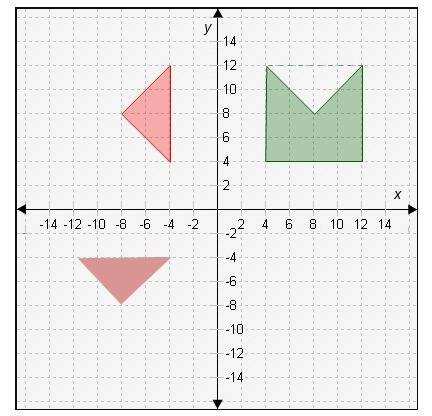
Mathematics, 10.07.2019 07:30, SmokeyRN
Which sequence of transformations on the red triangle will map it onto the missing portion of the square? a. a 90° counterclockwise rotation about the origin and then a translation 4 units right and 4 units downb. a 90° clockwise rotation about the origin and then a translation 4 units upc. a 90° counterclockwise rotation about the origin and then a translation 16 units right and 16 units upd. a 90° clockwise rotation about the origin and then a translation 16 units right and 16 units upe. a 180° rotation about the origin and then a translation 12 units right and 12 units up

Answers: 1
Other questions on the subject: Mathematics

Mathematics, 21.06.2019 16:00, pringleosmond
65 8 7 4 5 6 8 4 3 2 1 9 5 6 4 2 1 6 5 1 5 1 3 2 3 5 multiply the third number in the first row by the seventh number in the third row. add this result to the fifth number in the second row. add to this total ten times the fourth number in the third row. subtract the eighth number in the first row from the result.
Answers: 3


Mathematics, 21.06.2019 21:00, kitttimothy55
Julie buys 2kg of apples and 7kg of pears ? 12.70. the pears cost ? 1.30 per kilogram what is the price per kilogram of the apples? show your working out
Answers: 2

Mathematics, 21.06.2019 21:30, gonzalezashley152
In a test for esp (extrasensory perception), the experimenter looks at cards that are hidden from the subject. each card contains either a star, a circle, a wave, a cross or a square.(five shapes) as the experimenter looks at each of 20 cards in turn, the subject names the shape on the card. when the esp study described above discovers a subject whose performance appears to be better than guessing, the study continues at greater length. the experimenter looks at many cards bearing one of five shapes (star, square, circle, wave, and cross) in an order determined by random numbers. the subject cannot see the experimenter as he looks at each card in turn, in order to avoid any possible nonverbal clues. the answers of a subject who does not have esp should be independent observations, each with probability 1/5 of success. we record 1000 attempts. which of the following assumptions must be met in order to solve this problem? it's reasonable to assume normality 0.8(1000), 0.2(1000)%30 approximately normal 0.8(1000), 0.2(1000)% 10 approximately normal srs it is reasonable to assume the total number of cards is over 10,000 it is reasonable to assume the total number of cards is over 1000
Answers: 1
Do you know the correct answer?
Which sequence of transformations on the red triangle will map it onto the missing portion of the sq...
Questions in other subjects:





English, 14.01.2021 06:20











